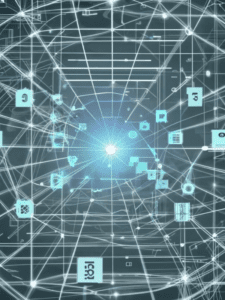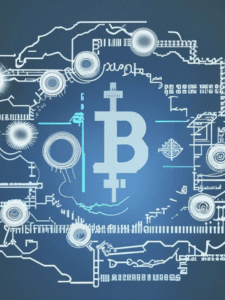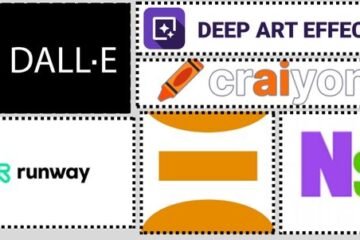Blockchain Security Triumphs: Protecting Digital Assets
Table of Contents
Definition of Blockchain:
Blockchain is a revolutionary technology that has redefined the way we think about data storage, security, and trust in the digital age. It is essentially a decentralized and distributed digital ledger that records transactions across a network of computers. This ledger consists of a chain of blocks, each containing a list of transactions. Here’s a more detailed breakdown of what blockchain is:
A Distributed Ledger: Blockchain operates on a vast network of computers, often referred to as nodes. These nodes work together to maintain the ledger, ensuring its integrity and security.
Transparency and Immutability: One of blockchain’s defining features is its transparency. Once a transaction is added to the blockchain, it cannot be altered or deleted. This immutability guarantees the integrity of the data, making blockchain highly resistant to fraud and manipulation.

Decentralization: Unlike traditional centralized systems, which rely on a single authority or intermediary, blockchain is decentralized. No single entity has control over the network, reducing the risk of single points of failure and enhancing security.
Cryptography: Blockchain relies on cryptographic techniques to secure data and ensure privacy. Each participant in the network has a public key and a private key, which are used to sign and verify transactions. This cryptographic approach ensures the authenticity and security of data.
Consensus Mechanisms: Blockchain employs consensus mechanisms, such as Proof of Work (PoW) and Proof of Stake (PoS), to validate and add transactions to the ledger. These mechanisms prevent unauthorized changes to the blockchain and maintain its security.
Smart Contracts: Smart contracts are self-executing contracts with predefined rules and conditions written in code. They automate and enforce agreements, further enhancing the security and transparency of transactions.
Importance of Blockchain Security:
The significance of blockchain security cannot be overstated. It plays a pivotal role in ensuring the success and trustworthiness of blockchain technology. Here are key reasons why blockchain security is of paramount importance:
Trust and Reliability: Blockchain technology is built on the premise of trust in a trustless environment. By securing data and transactions, it establishes trust among participants,
eliminating the need for intermediaries and reducing the risk of fraud.
Protecting Digital Assets:
In the context of cryptocurrencies like Bitcoin and Ethereum, blockchain security is crucial for
 safeguarding digital assets. Users need assurance that their investments are safe from theft and fraud.
safeguarding digital assets. Users need assurance that their investments are safe from theft and fraud.
Preventing Double Spending:
Blockchain security measures, particularly consensus mechanisms like PoW and PoS, prevent the double spending of digital assets. This ensures that a digital token cannot be spent more than once, maintaining the integrity of the ledger.
Data Privacy:
Blockchain’s use of cryptographic keys and its transparent yet secure ledger offer a high level of data privacy. It allows participants to transact with confidence, knowing that their sensitive information is protected.
Decentralization and Resilience:
Blockchain’s decentralized nature makes it resistant to single points of failure. Even if some nodes fail or are compromised, the network continues to function, ensuring system resilience.
Industry Adoption:
Blockchain is finding applications in various industries, from supply chain management to healthcare and finance. To foster widespread adoption, robust security measures are essential to gain the trust of businesses and individuals.
In summary, blockchain is a groundbreaking technology that relies on transparency, decentralization, cryptography, and consensus mechanisms to secure data and transactions. Its security is fundamental to its success and its ability to transform various sectors. As blockchain continues to evolve, so too will the security measures that underpin it, ensuring a safer and more trusted digital future.
The Fundamentals of Blockchain Security
Blockchain security is a multi-faceted domain, characterized by several fundamental elements that collectively ensure the integrity and reliability of this groundbreaking technology. These elements form the bedrock of blockchain security, providing the trust and transparency that define this innovative digital ledger system. Let’s delve into the key fundamentals of blockchain security:
1) Decentralization and Security

At the heart of blockchain security is the concept of decentralization. Unlike traditional centralized systems, where a single entity or authority controls data and transactions, blockchain operates on a network of distributed nodes. Each node on the network contains a copy of the entire ledger. This decentralized structure enhances security in several ways:
Reduced Single Points of Failure: In centralized systems, if the central authority is compromised, the entire system can be undermined. In contrast, blockchain’s decentralized nature means there’s no single point of failure, making it significantly more robust against attacks.
Resilience: Decentralization ensures the system’s resilience. Even if some nodes go offline or are compromised, the network continues to function, maintaining the security of the ledger.
Trust Through Consensus: Decentralization is also integral to the consensus mechanisms that validate and add transactions to the blockchain. Consensus mechanisms ensure that malicious actors cannot manipulate the ledger, thereby upholding the security of the network.
2) Cryptography and Privacy
Blockchain relies on cryptographic techniques to secure data and protect user privacy. Each participant in the network has a unique pair of cryptographic keys—a public key and a private key:
Public Key: This key is accessible to all participants and is used to generate a unique address on the blockchain. It can be shared freely and is essential for receiving transactions.
Private Key: This key is kept confidential and is used to sign and authorize transactions. Access to the private key provides control over the associated digital assets.
The use of cryptography provides several security advantages:
Authentication: Cryptographic keys ensure that the sender and receiver of a transaction can be authenticated, reducing the risk of fraudulent activities.
Data Privacy: Cryptography ensures the privacy of transaction details. While transactions are recorded on a public ledger, the details remain secure because they can only be decrypted with the private key.
3) Consensus Mechanisms
Consensus mechanisms are the protocols that enable network participants to agree on the state of the blockchain. These mechanisms are vital for maintaining security. Two common consensus mechanisms are:

Proof of Work (PoW): PoW requires participants (miners) to solve complex mathematical puzzles to validate transactions and add them to the blockchain. This process is resource-intensive and time-consuming, making it highly secure against malicious actors.
Proof of Stake (PoS): In PoS, validators are chosen to create new blocks and confirm transactions based on the amount of cryptocurrency they “stake” or lock up as collateral. PoS is energy-efficient and secure, reducing the risk of network attacks.
Consensus mechanisms ensure that transactions are validated fairly and securely, preventing unauthorized changes to the blockchain.
4) Smart Contract Security
Smart contracts are self-executing contracts with predefined rules and conditions written in code. These contracts are integral to many blockchain applications, such as decentralized finance (DeFi) and supply chain management. Ensuring the security of smart contracts is paramount:
Code Audits: Smart contracts should undergo thorough code audits to identify vulnerabilities and potential issues. Audits are conducted by security experts to minimize the risk of exploitation.
Testing: Rigorous testing of smart contracts is essential to ensure that they function as intended and do not contain vulnerabilities.
Secure Development Practices: Developers must follow secure coding practices to minimize risks associated with smart contracts, as vulnerabilities can lead to significant losses.
In short, the fundamentals of blockchain security—decentralization, cryptography, consensus mechanisms, and smart contract security—are essential components that ensure the robustness and trustworthiness of blockchain technology. These foundational elements work in harmony to safeguard data and transactions, providing users with confidence in the security of their digital assets and the reliability of blockchain systems.
Threats to Blockchain Security
Blockchain technology, despite its many security features, is not immune to various threats and vulnerabilities. Understanding these risks is crucial to implementing effective security measures. Here are five key threats to blockchain security:
1) 51% Attacks
A 51% attack, also known as a majority attack or double-spending attack, occurs when a single entity or a group of malicious actors gains control of over 50% of the computing power on a blockchain network. This attack enables them to manipulate transactions and potentially double-spend digital assets. Key aspects of 51% attacks include:
Double Spending: The attacker can spend the same cryptocurrency multiple times by reversing transactions after they have been confirmed, undermining the integrity of the ledger.
Undermining Consensus: By controlling the majority of the network’s computing power, the attacker can control the consensus process, allowing them to validate fraudulent transactions.
Preventing 51% attacks requires strong consensus mechanisms, a large and distributed network, and ongoing monitoring to detect and respond to unusual activities.
2) Double Spending
Double spending is a fundamental threat to any digital currency or asset. It occurs when a user spends the same digital currency more than once. In the context of blockchain, it can happen if a user initiates multiple transactions with the same cryptocurrency, intending to deceive the recipient. Key points regarding double spending include:
Confirmation Time: Most blockchain networks require a certain number of confirmations (blocks added to the chain) to consider a transaction final. Double spending is more challenging as the number of confirmations increases.
Risk Mitigation: For retailers and services, accepting transactions with a high number of confirmations can reduce the risk of double spending.
Preventing double spending relies on the robustness of the underlying consensus mechanism, making it computationally infeasible for a single user to control the majority of the network and manipulate transactions.
3) Sybil Attacks
A Sybil attack occurs when an attacker creates multiple fake identities or nodes on a network to gain control or influence. This type of attack is a significant threat to decentralized systems, including blockchain. Key elements of Sybil attacks include:
Faking Identity: Attackers create numerous fake identities or nodes, making it appear as if there are many participants, when in reality, they control all of them.
Consensus Manipulation: In blockchain, Sybil attackers can manipulate the consensus process by controlling a significant portion of the network.
Preventing Sybil attacks often involves mechanisms to verify the identities of network participants, such as requiring participants to prove computational work or stake digital assets.
4) Quantum Computing Threats
While not an immediate concern, the potential threat of quantum computing to blockchain security should be taken seriously. Quantum computers have the potential to break current blockchain encryption methods. Key points regarding quantum computing threats include:
Breaking Encryption: Quantum computers can theoretically break widely-used encryption algorithms, which could compromise the privacy and security of blockchain transactions.
Quantum-Resistant Cryptography: Researchers are working on quantum-resistant cryptographic algorithms that can secure blockchain networks against quantum threats.
Quantum computing threats are a long-term consideration, and the blockchain community is actively researching solutions to mitigate these risks.
5) Smart Contract Vulnerabilities
Smart contracts are not immune to vulnerabilities, and their security is of utmost importance. Vulnerabilities in smart contracts can lead to significant financial losses. Key aspects of smart contract vulnerabilities include:
Code Flaws: Smart contracts are written in code, and even small coding errors can lead to vulnerabilities that can be exploited.
Auditing and Testing: Conducting thorough code audits and rigorous testing is essential to identify and rectify vulnerabilities before deploying smart contracts.
Ongoing Monitoring: Smart contracts need continuous monitoring to detect and respond to any potential issues or vulnerabilities.
Addressing smart contract vulnerabilities requires secure development practices, code audits, and regular testing to ensure that smart contracts operate as intended and do not expose users to undue risks.
In summary, understanding and mitigating these threats to blockchain security is essential for maintaining the integrity and trustworthiness of blockchain networks. Security measures should continually evolve to stay ahead of potential risks and vulnerabilities.
Security Measures and Best Practices
The security of blockchain networks and digital assets is paramount in an environment where trust and integrity are foundational. Implementing robust security measures and best practices is essential to safeguard the decentralized nature of blockchain technology. Here are five key security measures and best practices:
1) Public and Private Keys
Public Key: A public key is an alphanumeric string generated from a user’s private key. It serves as the user’s address on the blockchain and is openly accessible. Public keys are used for receiving cryptocurrencies and validating transactions.
Private Key: A private key is a confidential and cryptographic string that pairs with the public key. It is used to authorize transactions and control access to digital assets. Keeping the private key secure is of utmost importance.
- Best Practice: Protect your private key at all costs. Store it offline, consider using hardware wallets, and avoid sharing it with anyone. Your private key is the key to your digital assets and must be kept safe.
2) Multi-Signature Wallets
Multi-signature (multi-sig) wallets require multiple private keys to authorize transactions, offering an added layer of security. For instance, a 2-of-3 multi-sig wallet would require two out of three private keys to sign a transaction.
- Best Practice: Utilize multi-signature wallets for significant holdings or critical transactions. They provide an extra security measure, reducing the risk of unauthorized access or fraudulent activities.
3) Cold Storage
Cold storage involves keeping a reserve of cryptocurrency offline, where it is safe from online threats, such as hacking and phishing. Common cold storage methods include hardware wallets, paper wallets, and offline computers.
- Best Practice: Use cold storage solutions to safeguard long-term cryptocurrency holdings. These assets remain protected from online threats, providing peace of mind and added security.
4) Consensus Protocol Choice
The choice of consensus protocol significantly impacts the security of a blockchain network. There are various consensus mechanisms, such as Proof of Work (PoW) and Proof of Stake (PoS), each with its own strengths and weaknesses. PoW requires miners to solve complex puzzles to validate transactions, making it highly secure. PoS relies on validators who stake cryptocurrency as collateral.
- Best Practice: Select the consensus mechanism that aligns with your network’s security goals and resource requirements. For instance, PoW is highly secure but resource-intensive, while PoS offers energy efficiency.
5) Code Audits and Smart Contract Testing
Smart contracts are integral to many blockchain applications. Ensuring their security is paramount. Regular code audits and rigorous testing help identify and rectify vulnerabilities and errors in smart contracts.
- Best Practice: Conduct thorough code audits by experienced security experts. Additionally, subject smart contracts to rigorous testing to uncover vulnerabilities before they are deployed. Continuous monitoring is essential to detect and respond to potential issues.
Implementing these security measures and best practices is essential for the safety and reliability of blockchain networks and the assets they support. By combining strong cryptographic protection, secure storage, and thorough auditing, blockchain participants can confidently engage with this transformative technology while mitigating potential risks.
Blockchain Security in Various Applications
Blockchain technology’s potential goes far beyond cryptocurrencies. It offers robust security solutions in diverse applications. Let’s explore how blockchain enhances security in four critical domains:
1) Cryptocurrency Security
Cryptocurrency security is fundamental to the widespread adoption and trust in digital currencies like Bitcoin, Ethereum, and many others. Blockchain provides several layers of security in this context:
Decentralization: The decentralized nature of blockchain prevents a single point of failure, making it challenging for malicious actors to compromise the network.
Cryptography: Strong cryptographic techniques secure transactions, making it nearly impossible for unauthorized parties to tamper with the data.
Consensus Mechanisms: Secure consensus mechanisms like Proof of Work (PoW) and Proof of Stake (PoS) prevent double spending and other fraudulent activities.
User Control: Users have direct control over their private keys, reducing the risk of theft or fraud.
2) Supply Chain Security
In supply chain security, blockchain offers transparency and traceability, reducing the risk of fraud, counterfeiting, and logistical errors. Key security benefits include:
Immutable Records: Once data is added to the blockchain, it cannot be altered, ensuring the integrity of the supply chain data.
Decentralization: Multiple participants verify and validate transactions, making it challenging for a single actor to manipulate the supply chain.
Smart Contracts: Self-executing smart contracts can automate various supply chain processes, ensuring that agreements are honored without manual intervention.
3) Healthcare Records Security
Healthcare records security is critical due to the sensitive and confidential nature of patient data. Blockchain enhances security through:
Data Privacy: Blockchain allows for the secure storage and sharing of healthcare records with controlled access, ensuring patient data remains confidential.
Interoperability: Patients, healthcare providers, and insurers can securely access and share data, enhancing healthcare services while maintaining data security.
Audit Trails: The immutability of the blockchain provides a transparent and secure audit trail of all changes to medical records, ensuring data integrity.
4) Voting System Security
Voting system security is essential for maintaining the integrity of elections and democratic processes. Blockchain can enhance voting security in several ways:
Identity Verification: Blockchain can be used to securely verify the identities of voters, reducing the risk of fraudulent voting.
Transparency: Every vote can be recorded on the blockchain, providing a transparent and tamper-resistant ledger of election results.
Remote Voting: Blockchain can enable secure remote voting, allowing more people to participate in the electoral process without compromising security.
Auditability: The blockchain’s immutability ensures that all voting records are permanently recorded and can be audited for accuracy.
In each of these applications, blockchain security plays a crucial role in enhancing trust, reducing fraud, and ensuring data integrity. As the technology continues to evolve, its applications in security-critical domains will expand, revolutionizing how we secure digital assets, supply chains, healthcare records, and voting systems.
Regulatory and Legal Aspects in Blockchain
Blockchain technology, despite its transformative potential, is subject to a complex web of regulatory and legal considerations. Addressing these aspects is essential for the technology’s widespread acceptance and integration into various industries. Two significant components of blockchain’s regulatory and legal landscape are:
1) Compliance with Regulations
Compliance with regulations is a paramount concern in the blockchain space. Different regions and countries have varying rules and requirements regarding the use of cryptocurrencies, security tokens, and decentralized applications (dApps). Key aspects of regulatory compliance include:
Know Your Customer (KYC) and Anti-Money Laundering (AML) Regulations: Many jurisdictions require blockchain entities to implement KYC and AML procedures to prevent illegal activities and protect against fraud.
Tax Regulations: Cryptocurrency transactions may be subject to taxation, and blockchain participants must understand and adhere to tax laws in their respective jurisdictions.
Securities Laws: The issuance of security tokens and initial coin offerings (ICOs) is subject to securities regulations in many countries.
Data Privacy Laws: Handling personal data on the blockchain must comply with data privacy regulations, such as the General Data Protection Regulation (GDPR) in the European Union.
Smart Contract Legality: Smart contracts may be considered legally binding agreements. Their use must align with contract law and related regulations.
Best Practice: To navigate the regulatory landscape, blockchain participants should seek legal counsel with expertise in blockchain and cryptocurrency laws. Understanding and adhering to relevant regulations is critical for avoiding legal complications.
2) Jurisdictional Challenges
Blockchain technology operates in a global, decentralized manner, transcending borders. However, jurisdictional challenges arise when blockchain transactions and entities cross international boundaries. Key points concerning jurisdictional challenges include:
Conflict of Laws: Legal conflicts may occur when blockchain transactions involve multiple jurisdictions with differing regulations.
Enforcement: Enforcing legal actions across borders can be complex. A judgment in one jurisdiction may not be readily enforceable in another.
Regulatory Arbitrage: Some entities may seek out jurisdictions with more favorable blockchain regulations, creating regulatory arbitrage challenges.
Legal Uncertainty: The evolving nature of blockchain technology can create legal uncertainty, making it challenging for regulators to keep pace with innovation.
Interoperability: Ensuring interoperability between different blockchain networks operating in various jurisdictions can be a challenge.
Best Practice: To address jurisdictional challenges, blockchain participants should engage with legal experts who understand the complexities of cross-border transactions. Additionally, international collaborations and regulatory harmonization efforts can contribute to a more streamlined legal environment for blockchain.
In summary, regulatory and legal aspects play a pivotal role in shaping the future of blockchain technology. As the technology continues to evolve and find applications in various industries, regulatory compliance and addressing jurisdictional challenges are essential for maintaining trust, ensuring legal integrity, and fostering blockchain’s acceptance on a global scale.
Future Trends in Blockchain Security
Blockchain technology continues to evolve, and so do the threats it faces. Staying ahead of emerging risks and vulnerabilities is vital to maintaining the security and integrity of blockchain networks. Here are three key future trends in blockchain security:
1) Post-Quantum Cryptography
The advent of quantum computing poses a significant threat to traditional cryptographic methods, which secure blockchain networks. Quantum computers have the potential to break widely-used encryption algorithms, compromising the privacy and security of blockchain transactions. To counter this threat, the future trend in blockchain security is post-quantum cryptography:
Quantum-Resistant Algorithms: Researchers are actively developing quantum-resistant cryptographic algorithms that can secure blockchain networks against quantum threats. These algorithms are designed to withstand attacks from quantum computers, ensuring the ongoing security of blockchain systems.
Hybrid Approaches: A combination of classical and quantum-resistant cryptographic methods may be employed to protect blockchain networks from both current and future threats.
2) Zero-Knowledge Proofs
Zero-knowledge proofs are cryptographic techniques that allow one party (the prover) to prove to another party (the verifier) that a statement is true without revealing the underlying information. This concept has profound implications for blockchain security:
Privacy-Preserving Transactions: Zero-knowledge proofs enable blockchain users to prove ownership or knowledge of specific data without disclosing that data. This enhances privacy and confidentiality in blockchain transactions.
Security Enhancements: Zero-knowledge proofs can be used to verify the validity of transactions without revealing sensitive details. This reduces the risk of exposing critical information to potential attackers.
Scalability: Zero-knowledge proofs can improve the efficiency and scalability of blockchain networks by reducing the computational burden of transaction verification.
3) AI and Blockchain Security
Artificial intelligence (AI) is becoming an increasingly valuable tool in blockchain security. AI technologies can analyze vast amounts of data, detect anomalies, and identify potential security threats in real-time. Key applications of AI in blockchain security include:
Threat Detection: AI algorithms can continuously monitor blockchain networks for suspicious activities, enabling the early detection of potential threats or attacks.
User Behavior Analysis: AI can analyze user behavior patterns to identify unusual or potentially malicious activities, providing an additional layer of security.
Predictive Analytics: AI can be used to predict and prevent security breaches by analyzing historical data and identifying vulnerabilities.
Automated Response: AI-driven security systems can respond to threats autonomously, mitigating potential risks in real-time.
These future trends in blockchain security reflect the industry’s commitment to adapting and innovating to stay ahead of emerging threats. As blockchain technology becomes more integrated into various sectors, the evolution of security measures and practices is vital to ensure the continued trust and integrity of blockchain networks.
Real-World Examples of Blockchain Security
Blockchain technology has experienced both notable successes and security challenges in its relatively short history. Here are some real-world examples that highlight the dynamics of blockchain security:
1) The DAO Hack
The DAO (Decentralized Autonomous Organization) was a pioneering smart contract on the Ethereum blockchain designed to create a decentralized venture capital fund. In 2016, it faced a significant security breach:
The Hack: An attacker exploited a vulnerability in the DAO’s smart contract code, draining approximately one-third of its assets, equivalent to millions of dollars in Ether (ETH).
Hard Fork Controversy: To mitigate the impact of the hack, the Ethereum community controversially decided to execute a hard fork, which reversed the effects of the attack. This decision created a split in the Ethereum community, leading to the emergence of Ethereum Classic.
Lessons Learned: The DAO hack highlighted the importance of secure smart contract development and the challenges of mitigating breaches in a decentralized, immutable blockchain. It led to increased scrutiny of smart contract security and a greater emphasis on auditing and code quality.
2) Bitcoin’s Security Track Record
Bitcoin, the first and most well-known cryptocurrency, has demonstrated remarkable security resilience since its inception in 2009:
Unbroken Ledger: Bitcoin’s blockchain has never been hacked or compromised. Its security mechanisms, including Proof of Work (PoW) consensus, have effectively protected the network against attacks.
Longevity: Bitcoin has operated for over a decade without any major security breaches. This track record contributes to its reputation as a secure and reliable store of value.
Secure Development: The Bitcoin community prioritizes security in its development practices, regularly reviewing and enhancing the protocol to maintain its integrity.
3) Successful Security Implementations
Blockchain technology has seen successful security implementations in various sectors:
Supply Chain: Companies like IBM and Walmart have implemented blockchain-based supply chain solutions to enhance transparency and traceability. These systems reduce the risk of counterfeit products and unauthorized alterations in the supply chain.
Healthcare: Blockchain is being used to secure healthcare records. Projects like MedRec allow patients to have control over their data while ensuring privacy and security through blockchain technology.
Voting Systems: Several countries and organizations are exploring blockchain for secure and transparent voting systems. Blockchain can enhance the integrity of elections by providing a tamper-resistant ledger.
Cross-Border Payments: Ripple’s XRP blockchain is being used to facilitate cross-border payments, offering faster, more secure, and cost-effective transactions.
These successful security implementations showcase the adaptability of blockchain technology in addressing real-world challenges and enhancing security and transparency in various domains.
In summary, blockchain security has seen its share of challenges and successes. The DAO hack underscored the importance of rigorous smart contract security, while Bitcoin’s resilience over the years has solidified its reputation as a secure digital asset. Furthermore, successful blockchain implementations in various industries demonstrate the technology’s potential to enhance security, transparency, and efficiency in real-world applications.
Conclusion: The Ongoing Evolution of Blockchain Security
Blockchain technology, with its promise of decentralization, transparency, and security, has sparked a revolution in how we manage and exchange digital assets. However, its evolution is inextricably linked to the ongoing challenges and innovations in the realm of security.
The journey of blockchain security has been marked by significant milestones, from the inception of Bitcoin’s unbroken ledger to the challenges posed by the DAO hack. These real-world examples have underscored the importance of robust security practices and continuous vigilance in the face of evolving threats.
As we move forward, several trends are shaping the future of blockchain security. Post-quantum cryptography is emerging as a critical safeguard against the potential threat of quantum computing. Zero-knowledge proofs offer enhanced privacy and confidentiality in transactions. Meanwhile, artificial intelligence is playing a crucial role in the early detection and mitigation of security threats.
The ongoing evolution of blockchain security is driven by a deep commitment to enhancing trust, reducing fraud, and ensuring data integrity across various applications, from cryptocurrency to supply chains, healthcare records, and voting systems. As these trends continue to mature, blockchain technology will likely see increased adoption and integration into the fabric of our digital world.
In this dynamic landscape, blockchain security is not a fixed state but a continuous journey. It requires the collaboration of technologists, security experts, legal professionals, and regulatory bodies to strike a balance between innovation and protection. As the blockchain ecosystem matures and the security landscape evolves, it is our collective responsibility to ensure that blockchain remains a secure and trusted technology for the future.
The ongoing evolution of blockchain security reflects the resilience and adaptability of this transformative technology. As it continues to shape industries and revolutionize how we interact with digital assets and information, maintaining the highest standards of security will be essential in realizing its full potential.
Unique FAQs
1. Can blockchain security be hacked?
Blockchain security is highly robust, but not entirely immune to attacks. The risk is significantly lower than traditional systems, but it’s essential to stay vigilant.
2. What is the role of quantum computing in blockchain security?
Quantum computing poses a potential threat to current blockchain encryption methods. The development of quantum-resistant algorithms is a priority.
3. How can I ensure the security of my cryptocurrency investments?
Use secure wallets, enable multi-signature options, and stay updated on the latest security practices.
4. Are smart contracts safe to use?
Smart contracts are safe if they are well-audited and free from vulnerabilities. It’s crucial to have them reviewed by experts to minimize risks.
5. What are the regulatory challenges in blockchain?
Blockchain projects often encounter regulatory hurdles due to varying laws and jurisdictions. Staying compliant with local regulations is a complex yet necessary task for blockchain developers.
In conclusion, blockchain security is an ever-evolving domain, with continuous advancements and innovations aimed at safeguarding decentralized systems. As blockchain technology becomes increasingly integrated into our daily lives, understanding the threats it faces and adopting best practices is crucial. By staying informed and taking proactive steps, individuals and businesses can enjoy the benefits of blockchain while minimizing the associated risks.
Blockchain security, driven by principles such as decentralization, cryptography, and consensus mechanisms, is the foundation upon which trust is built in this transformative technology. As the blockchain landscape continues to evolve, so too must its security measures, ensuring a resilient and secure digital future.




0 Comments